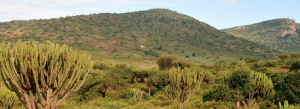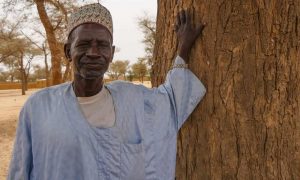
The world has warmed more than one degree Celsius since the Industrial Revolution. The Paris climate agreement — the nonbinding, unenforceable and already unheeded treaty signed on Earth Day in 2016 — hoped to restrict warming to two degrees. The odds of succeeding, according to a recent study based on current emissions trends, are one in 20. If by some miracle we are able to limit warming to two degrees, we will only have to negotiate the extinction of the world’s tropical reefs, sea-level rise of several meters and the abandonment of the Persian Gulf. The climate scientist James Hansen has called two-degree warming “a prescription for long-term disaster.” Long-term disaster is now the best-case scenario. Three-degree warming is a prescription for short-term disaster: forests in the Arctic and the loss of most coastal cities. Robert Watson, a former director of the United Nations Intergovernmental Panel on Climate Change, has argued that three-degree warming is the realistic minimum. Four degrees: Europe in permanent drought; vast areas of China, India and Bangladesh claimed by desert; Polynesia swallowed by the sea; the Colorado River thinned to a trickle; the American Southwest largely uninhabitable. The prospect of a five-degree warming has prompted some of the world’s leading climate scientists to warn of the end of human civilization.
Is it a comfort or a curse, the knowledge that we could have avoided all this?
Because in the decade that ran from 1979 to 1989, we had an excellent opportunity to solve the climate crisis. The world’s major powers came within several signatures of endorsing a binding, global framework to reduce carbon emissions — far closer than we’ve come since. During those years, the conditions for success could not have been more favorable. The obstacles we blame for our current inaction had yet to emerge. Almost nothing stood in our way — nothing except ourselves.
Nearly everything we understand about global warming was understood in 1979. By that year, data collected since 1957 confirmed what had been known since before the turn of the 20th century: Human beings have altered Earth’s atmosphere through the indiscriminate burning of fossil fuels. The main scientific questions were settled beyond debate, and as the 1980s began, attention turned from diagnosis of the problem to refinement of the predicted consequences. Compared with string theory and genetic engineering, the “greenhouse effect” — a metaphor dating to the early 1900s — was ancient history, described in any Introduction to Biology textbook. Nor was the basic science especially complicated. It could be reduced to a simple axiom: The more carbon dioxide in the atmosphere, the warmer the planet. And every year, by burning coal, oil and gas, humankind belched increasingly obscene quantities of carbon dioxide into the atmosphere.
Why didn’t we act? A common boogeyman today is the fossil-fuel industry, which in recent decades has committed to playing the role of villain with comic-book bravado. An entire subfield of climate literature has chronicled the machinations of industry lobbyists, the corruption of scientists and the propaganda campaigns that even now continue to debase the political debate, long after the largest oil-and-gas companies have abandoned the dumb show of denialism. But the coordinated efforts to bewilder the public did not begin in earnest until the end of 1989. During the preceding decade, some of the largest oil companies, including Exxon and Shell, made good-faith efforts to understand the scope of the crisis and grapple with possible solutions.
Nor can the Republican Party be blamed. Today, only 42 percent of Republicans know that “most scientists believe global warming is occurring,” and that percentage is falling. But during the 1980s, many prominent Republicans joined Democrats in judging the climate problem to be a rare political winner: nonpartisan and of the highest possible stakes. Among those who called for urgent, immediate and far-reaching climate policy were Senators John Chafee, Robert Stafford and David Durenberger; the E.P.A. administrator, William K. Reilly; and, during his campaign for president, George H.W. Bush. As Malcolm Forbes Baldwin, the acting chairman of the president’s Council for Environmental Quality, told industry executives in 1981, “There can be no more important or conservative concern than the protection of the globe itself.” The issue was unimpeachable, like support for veterans or small business. Except the climate had an even broader constituency, composed of every human being on Earth.
It was understood that action would have to come immediately. At the start of the 1980s, scientists within the federal government predicted that conclusive evidence of warming would appear on the global temperature record by the end of the decade, at which point it would be too late to avoid disaster. More than 30 percent of the human population lacked access to electricity. Billions of people would not need to attain the “American way of life” in order to drastically increase global carbon emissions; a light bulb in every village would do it. A report prepared at the request of the White House by the National Academy of Sciences advised that “the carbon-dioxide issue should appear on the international agenda in a context that will maximize cooperation and consensus-building and minimize political manipulation, controversy and division.” If the world had adopted the proposal widely endorsed at the end of the ’80s — a freezing of carbon emissions, with a reduction of 20 percent by 2005 — warming could have been held to less than 1.5 degrees.
A broad international consensus had settled on a solution: a global treaty to curb carbon emissions. The idea began to coalesce as early as February 1979, at the first World Climate Conference in Geneva, when scientists from 50 nations agreed unanimously that it was “urgently necessary” to act. Four months later, at the Group of 7 meeting in Tokyo, the leaders of the world’s seven wealthiest nations signed a statement resolving to reduce carbon emissions. Ten years later, the first major diplomatic meeting to approve the framework for a binding treaty was called in the Netherlands. Delegates from more than 60 nations attended, with the goal of establishing a global summit meeting to be held about a year later. Among scientists and world leaders, the sentiment was unanimous: Action had to be taken, and the United States would need to lead. It didn’t.
The inaugural chapter of the climate-change saga is over. In that chapter — call it Apprehension — we identified the threat and its consequences. We spoke, with increasing urgency and self-delusion, of the prospect of triumphing against long odds. But we did not seriously consider the prospect of failure. We understood what failure would mean for global temperatures, coastlines, agricultural yield, immigration patterns, the world economy. But we have not allowed ourselves to comprehend what failure might mean for us. How will it change the way we see ourselves, how we remember the past, how we imagine the future? Why did we do this to ourselves? These questions will be the subject of climate change’s second chapter — call it The Reckoning. There can be no understanding of our current and future predicament without understanding why we failed to solve this problem when we had the chance.
That we came so close, as a civilization, to breaking our suicide pact with fossil fuels can be credited to the efforts of a handful of people, among them a hyperkinetic lobbyist and a guileless atmospheric physicist who, at great personal cost, tried to warn humanity of what was coming. They risked their careers in a painful, escalating campaign to solve the problem, first in scientific reports, later through conventional avenues of political persuasion and finally with a strategy of public shaming. Their efforts were shrewd, passionate, robust. And they failed. What follows is their story, and ours.
Click here to read more.
Originally published by the New York Times
 A new web-based application now makes it possible for small-scale farmers to see the African forests for the trees.
A new web-based application now makes it possible for small-scale farmers to see the African forests for the trees.





